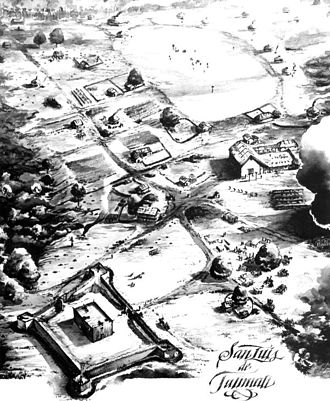
Chapter I (quotes from the book are in olive)
This chapter opens with a declaration that rings like that of the trumpets that sound at the unrolling of a scroll at the end of days. As I have told innumerable visitors to Lichgate over the years, Laura had the unique ability to see 500 years into the past, the present, and 500 years into the future and hold all these visions simultaneously.
This ability is reflected in the opening paragraph
that takes the entire first page of her book.
In it we travel from the days of Elizabeth and
Shakespeare, to a distant future where all that remains of
the cottage are stones from a toppled chimney and a
rectangle of granite to mark where her home once stood.
Here is the opening paragraph;
“O triumphant
and transporting thought, that some antiquary in years to
come should unearth Lichgate on High Road and consider it a
site memorable in the annals of Tallahassee, that he should
conclude not that in Tallahassee, (Old Town of the Indians),
he had discovered arrowheads, stone chisels, shards of
pottery, or that he had found ruins of a somewhat later
period, cannon balls and muskets in what was presumably the
Spanish fort of San Luis, but that, exhuming Lichgate, he
should imagine he had found himself among the shades of
Tudor England of the sixteenth century, when Henry VIII and
his daughter Elizabeth walked the earth and the Old Globe
echoed the meters of Shakespeare.
Palimpsests of ancient days have recorded such
erroneous observations.”
One
word from this opening paragraph stands out and deserves a
story all its own, that word is palimpsest. There is an
entire page of this site dedicated to this single word and
if you are interested in its story simply follow the link
provided here.
-
Laura's knowledge of the work done by various archeologists as noted in an article from National Park Service, San Luis de Talimali, Tallahassee, FL, "Prior to Florida purchasing the land, archeologists had studied the site intensively. John W. Griffin, Hale G. Smith, and Charles H. Fairbanks – all leading Floridian archeologists – investigated the site of San Luis in the 1940s and ‘50s"
-
Laura references one of her favorite authors, Shakespeare
-
Laura sets the stage for the later description of her cottage as being Tudor-styled, a style dating from the Tudor period of 1485-1603, coinciding with the life of Shakespeare, (1564-1616)
-
She uses the word palimpsest which refers to her first published article from 1934, see link to that story above
-
She sets the stage for dating the age of the Lichgate Oak, later on in her book asking the question, "Was it a sapling when Shakespeare was boy?" (Chapter IX, 4th paragraph)
Paragraphs 2 & 3
"In
narrating the history of this house I am merely anticipating
the explorations of that antiquary who, upon discovering
relics, infers that foundations of the present are quite
literally laid on the ashes of the past.
The foundation of this house, however, was laid on the
imaginary ashes of a previous civilization.
Peace be with those ashes!
The past is part of
all of us.
When landmarks are so rapidly disappearing it is salutary to
remind ourselves that we cannot escape the past no matter
how intently we fix our eyes on the future.
Yet the fortunate and the patient may, to a certain extent,
reverse time, so that experiences which time has seemingly
expunged can be recovered.
Thus the dead past becomes the perennial present.
The background of these two paragraphs connects
many threads of Laura’s life.
In especially the second paragraph above we see
echoes of one of her favorite poets, T. S. Eliot, (for more
information please visit the Music
page on this site).
To explore the connections of poet, philosophy and
Laura’s words I will draw heavily on a recent article
written by Dwight Longenecker posted on the site Imaginative
Conservative.
The article is entitled, “Time,
Tradition and T. S. Eliot” and speaks to Eliot’s sense
of time and eternity especially in his later poem, “Four
Quartets”. The
opening lines of the poem are as follows;
Time present and
time past
Are both perhaps present in time future,
And
time future contained in time past.
If all time is
eternally present.
With these words Eliot tells us of his view of
time, the past and the future contained in the present, a
holy trinity of time in Longenecker’s words, three in one.
This view of time and eternity reflected Laura’s own
lens on the world, shadows of the past and future always
seen in the present.